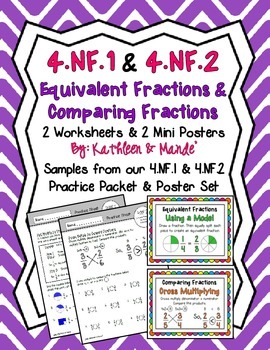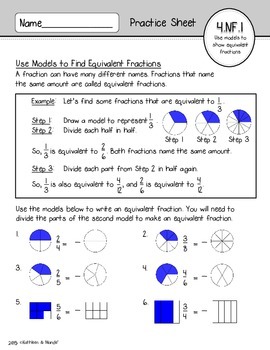4.NF.1 & 4.NF.2 FREEBIE: Equivalent Fractions & Comparing Fractions Practice
159,986 Downloads
Kathleen and Mande'
10k Followers
Grade Levels
3rd - 5th
Subjects
Resource Type
Standards
CCSS4.NF.A.1
CCSS4.NF.A.2
Formats Included
- PDF
- Easel Activity
Pages
5 pages
FREE
Kathleen and Mande'
10k Followers
Easel Activity Included
This resource includes a ready-to-use interactive activity students can complete on any device. Easel by TPT is free to use! Learn more.
Description
Enjoy these free practice sheets on modeling equivalent fractions and comparing fractions with cross multiplying. These skills are part of the 4.NF.1 and 4.NF.2 fraction standards.
If you enjoy these practice sheets, be sure to check out our full size
4.NF.1 & 4.NF.2 PRACTICE SHEET PACKET for Equivalent Fractions & Comparing Fractions (24 sheets in all)
Also available for 4.NF.1 and 4.NF.2:
4.NF.1 & 4.NF.2 POSTER SET for Equivalent Fractions & Comparing Fractions
4.NF.1 & 4.NF.2 TASK CARDS for Equivalent Fractions & Comparing Fractions
This packet includes 24 pages of fraction practice including foundation skills, equivalent fractions (multiplying, models, missing values, simplifying, identifying equivalent pairs) and comparing fractions (models, benchmark fractions, common denominators, cross multiplying, and ordering 3 fractions).
Enjoy!
Kathleen and Mande'
If you enjoy these practice sheets, be sure to check out our full size
4.NF.1 & 4.NF.2 PRACTICE SHEET PACKET for Equivalent Fractions & Comparing Fractions (24 sheets in all)
Also available for 4.NF.1 and 4.NF.2:
4.NF.1 & 4.NF.2 POSTER SET for Equivalent Fractions & Comparing Fractions
4.NF.1 & 4.NF.2 TASK CARDS for Equivalent Fractions & Comparing Fractions
This packet includes 24 pages of fraction practice including foundation skills, equivalent fractions (multiplying, models, missing values, simplifying, identifying equivalent pairs) and comparing fractions (models, benchmark fractions, common denominators, cross multiplying, and ordering 3 fractions).
Enjoy!
Kathleen and Mande'
Total Pages
5 pages
Answer Key
Not Included
Teaching Duration
N/A
Report this resource to TPT
Reported resources will be reviewed by our team. Report this resource to let us know if this resource violates TPT’s content guidelines.
Standards
to see state-specific standards (only available in the US).
CCSS4.NF.A.1
Explain why a fraction 𝘢/𝘣 is equivalent to a fraction (𝘯 × 𝘢)/(𝘯 × 𝘣) by using visual fraction models, with attention to how the number and size of the parts differ even though the two fractions themselves are the same size. Use this principle to recognize and generate equivalent fractions.
CCSS4.NF.A.2
Compare two fractions with different numerators and different denominators, e.g., by creating common denominators or numerators, or by comparing to a benchmark fraction such as 1/2. Recognize that comparisons are valid only when the two fractions refer to the same whole. Record the results of comparisons with symbols >, =, or <, and justify the conclusions, e.g., by using a visual fraction model.






